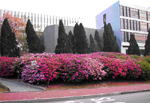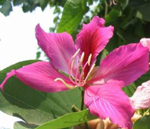

![]() 06 Mar 2007,
Issue 8
06 Mar 2007,
Issue 8


 |
 |
 |

| Flower Power | |
Blossoming flowers, a sign of auspiciousness and prosperity especially during the Chinese New Year, can be found at almost every corner of the CUHK campus. In fact, the University is home to some 200 plant species. How many of the following popular species do you know? |
|
Azalea The most commonly known plant on campus is the azalea, which usually blooms in March and April. The azalea belongs to the Ericaceae family. A native of warm temperate zones in Asia, Europe, and North America, azaleas are widely scattered over the world. There are 800+ wild species, over 600 of which can be found in China. The white azalea discovered locally is named the Hong Kong Azalea. Wild azaleas are protected by law and picking is prohibited. Species on campus include the red azalea, the white azalea, the Hong Kong azalea, and the Farrers azalea. Bauhinia and Bauhinia Blakeana There is an abundance of bauhinia blakeana and bauhinia on campus. They exist side by side at the University Mall, on the slope leading to the Institute of Chinese Studies and in Cultural Square outside the Benjamin Franklin Centre. The two are very similar both being Caesalpiniaceae and both having heart-shaped leaves. However, it is easy to tell them apart from their flowers and pods. The bauhinia blakeana is infertile; it does not produce seeds and has to be propagated by grafting and other methods while the bauhinia bears dark flattened pods. So plants with pods are likely to be bauhinia otherwise are bauhinia blakeana. Their flowers are also very different. The bauhinia blakeeana blooms from November to March and has bigger pinkish purple flowers, whereas the bauhinia seen on campus includes the red bauhinia (bauhinia purpura), white bauhinia (bauhinia variegate L.), and pure-white bauhinia (bauhinia variegate L. Var. candida). Bauhinia blakeana is the floral emblem of Hong Kong and it was named in 1908 after Sir Henry Blake, the then Governor of Hong Kong, as a recognition of his support for the Botanical Gardens. According to the latest satellite pictures provided by the Joint Laboratory for Geoinformation Science, 77% of the campus is covered by vegetation. To learn more about other plant species commonly found on campus, please visit: http://www.cuhk.edu.hk/greencampus/en/fandf.htm. References: |
|
| Top | |
Please send enquiries,
suggestions and contributions to cu.aao@cuhk.edu.hk
Copyright © 2025. Alumni Affairs Office, CUHK
Rm 301, 3/F, John Fulton Centre,
The Chinese University of Hong Kong
Tel: 2609 7861 Fax: 2603 6226
